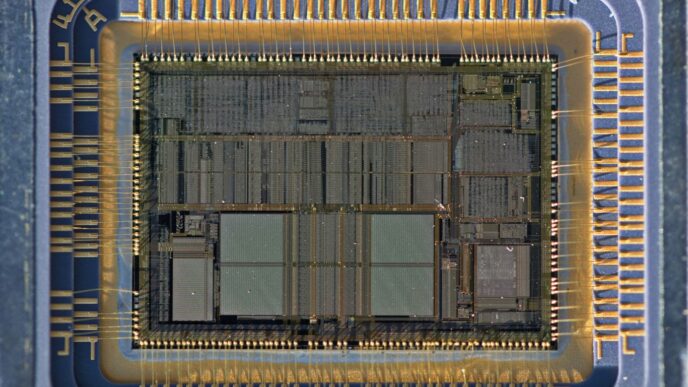America’s technological journey has been nothing short of remarkable, marked by innovations that have transformed everyday life. From the first personal computers to the smartphones in our pockets, these advancements have shaped how we communicate, work, and play. This article explores the pivotal moments in America’s tech revolution through 39 iconic photos, each telling a story of progress and change.
Key Takeaways
- The launch of the Apple Macintosh revolutionised personal computing, making it accessible to many.
- The rise of smartphones, especially with the introduction of the iPhone, changed how we interact with technology.
- Television evolved significantly, with the Sony Trinitron setting new standards for visual entertainment.
- Digital cameras and smartphones have transformed photography, allowing anyone to capture moments instantly.
- The introduction of e-readers like the Amazon Kindle has changed the way we consume literature.
The Dawn of Personal Computing

Apple Macintosh’s Influence
The Apple Macintosh was a game changer in personal computing. Launched in 1984, it introduced a graphical user interface that made computers more accessible to everyday users. This innovation set the stage for how we interact with technology today.
Rise of Microsoft Operating Systems
Following the Macintosh, Microsoft began to dominate the market with its operating systems. The introduction of Windows made personal computers more user-friendly and affordable. This led to a significant increase in home computer ownership.
Commodore 64: A Game Changer
The Commodore 64 was one of the first personal computers to gain widespread popularity. Released in 1982, it was known for its affordability and versatility, making it a favourite among families and gamers alike. Over 17 million units were sold, showcasing its impact on the tech landscape.
| Year | Product | Key Feature |
|---|---|---|
| 1984 | Apple Macintosh | Graphical User Interface |
| 1985 | Microsoft Windows | User-friendly interface |
| 1982 | Commodore 64 | Affordable and versatile |
- Key Innovations in Personal Computing:
- Introduction of graphical user interfaces.
- Affordable pricing of personal computers.
- Rise of software applications for home use.
The history of personal computers shows that after the development of the microprocessor, individual personal computers became affordable consumer goods, leading to a tech revolution that changed our lives forever.
Revolutionising Communication
The Birth of the Internet
The internet’s creation in the late 20th century transformed how we connect. It began as a military project and evolved into a global network. Key milestones include:
- ARPANET: The first operational packet-switching network.
- World Wide Web: Introduced by Tim Berners-Lee in 1991, making the internet user-friendly.
- Email: Revolutionised communication, allowing instant messaging.
Smartphones and the iPhone Era
The launch of the iPhone in 2007 marked a significant shift in mobile communication. It combined a phone, internet browser, and media player into one device. Key features include:
- Touchscreen interface: Made navigation intuitive.
- App Store: Allowed users to download applications for various tasks.
- Camera: Integrated high-quality photography into daily life.
Social Media Platforms
Social media has changed how we interact. Platforms like Facebook, Twitter, and Instagram allow users to share experiences instantly. Key impacts include:
- Global connectivity: People can connect across continents.
- Information sharing: News spreads rapidly, sometimes outpacing traditional media.
- Community building: Users can find and connect with like-minded individuals.
The evolution of communication technology has reshaped our world, making it more interconnected than ever before. Innovations like smartphones and social media have created new ways to share and connect, influencing every aspect of our lives.
| Year | Milestone | Description |
|---|---|---|
| 1969 | ARPANET | First packet-switching network |
| 1991 | World Wide Web | User-friendly internet access |
| 2007 | iPhone | Revolutionised mobile communication |
Pioneering Visual Entertainment

Sony Trinitron’s Legacy
The Sony Trinitron television, launched in 1968, revolutionised the way we viewed colour TV. It combined three electron guns into one, providing a clearer and more vibrant picture. This innovation not only won an Emmy award but also sold over 100 million units worldwide, making it a household name.
The Evolution of Televisions
Television technology has undergone significant changes over the decades. Here are some key milestones:
- CRT to LCD: Transition from bulky cathode ray tubes to sleek LCD screens.
- HD to 4K: The shift from standard definition to high definition and now to 4K resolution.
- Smart TVs: Integration of internet connectivity, allowing access to streaming services and apps.
Streaming Services
The rise of streaming services has transformed how we consume visual entertainment. Platforms like Netflix and Hulu have changed viewing habits, leading to a decline in traditional cable subscriptions. Here’s a brief overview of their impact:
| Year | Service | Subscribers (millions) |
|---|---|---|
| 2007 | Netflix | 7 |
| 2020 | Netflix | 203 |
| 2021 | Disney+ | 116 |
The advent of streaming has made it easier for viewers to access a vast library of content at their convenience, reshaping the entertainment landscape.
In summary, the journey of visual entertainment from the Sony Trinitron to modern streaming services illustrates a remarkable evolution, driven by technological advancements and changing consumer preferences.
Photography’s Digital Transformation
Kodak Brownie Camera
The Kodak Brownie camera revolutionised photography by making it accessible to everyone. Launched in 1900, it was affordable at just $1, allowing people to take snapshots easily. This small camera changed how we captured moments, leading to a new relationship with images. It was a game changer for both Kodak and the public, as it encouraged film sales and made photography a part of everyday life.
The Polaroid Revolution
The Polaroid camera introduced instant photography in 1977, allowing users to see their photos moments after taking them. This innovation appealed to many, making it a best-seller. Polaroid photos became iconic, often found in family albums and pop culture. The instant gratification it provided is still celebrated today, influencing modern photography and apps like Instagram.
Digital Cameras and Smartphones
The rise of digital cameras and smartphones has transformed photography further. Digital cameras replaced film, allowing for immediate viewing and editing of photos. Smartphones, equipped with high-quality cameras, have made photography even more accessible. Today, almost everyone carries a camera in their pocket, leading to a surge in photo sharing on social media platforms.
| Year | Innovation | Impact |
|---|---|---|
| 1900 | Kodak Brownie Camera | Made photography accessible to the masses |
| 1977 | Polaroid Camera | Introduced instant photography |
| 2000s | Digital Cameras | Replaced film, enabling instant viewing |
| 2010s | Smartphones | Integrated cameras, leading to photo sharing |
The transformation of photography from an analogue medium relying on chemically developed light-sensitive emulsions to one using digital technologies has reshaped how we capture and share our lives.
In summary, the journey from the Kodak Brownie to smartphones illustrates how photography has evolved, making it an integral part of our daily lives. This digital transformation has changed our relationship with images forever.
Innovations in Music Consumption
The Sony Walkman
The Sony Walkman was a groundbreaking device that changed how people listened to music. It was the first portable music player that combined ease of use, affordability, and portability. This small cassette player allowed users to enjoy their favourite tunes on the go, creating a personal listening experience. Over 200 million units were sold, paving the way for future music devices.
Apple iPod’s Impact
The Apple iPod revolutionised music consumption by allowing users to carry thousands of songs in their pockets. It made it easy to switch from CDs to digital music, and the iTunes Store provided a platform for purchasing songs legally. This device not only changed how we listen to music but also helped revive the music industry during a time of decline.
Streaming Music Services
With the rise of streaming music services, listening to music became more accessible than ever. Platforms like Spotify and Apple Music allow users to stream millions of songs without needing to own them. This shift has changed the music landscape, making it easier for artists to reach audiences and for listeners to discover new music.
Summary of Key Innovations
| Innovation | Year Introduced | Impact on Music Consumption |
|---|---|---|
| Sony Walkman | 1979 | First portable music player |
| Apple iPod | 2001 | Shifted music from physical to digital |
| Streaming Services | 2000s | Made music accessible anytime, anywhere |
The evolution of music consumption reflects broader changes in technology and society, highlighting how innovation can reshape our daily lives.
Conclusion
These innovations have not only transformed how we consume music but have also influenced the music industry as a whole. From the Walkman to the iPod and now to streaming services, each step has made music more accessible and enjoyable for everyone.
Advancements in Reading Technology
The Rise of E-Readers
E-readers have transformed how we consume literature. Devices like the Amazon Kindle have made it easier to carry thousands of books in one lightweight gadget. This shift has led to a significant change in reading habits, with many preferring digital formats over traditional paper books.
Amazon Kindle’s Dominance
The Amazon Kindle quickly became the best-selling e-reader, changing the landscape of reading. Its features include:
- Adjustable font sizes
- Built-in dictionaries
- Access to a vast library of e-books
This device has made reading more accessible and convenient for many.
Digital Libraries
Digital libraries have emerged as a vital resource for readers. They offer:
- A wide range of genres and titles
- Easy access from anywhere with an internet connection
- The ability to borrow books without late fees
These advancements have made reading more inclusive and flexible.
The evolution of reading technology has not only changed how we read but also how we think about books and literature. Digital formats have opened up new possibilities for readers everywhere.
Summary Table of Reading Technology Advancements
| Technology | Year Introduced | Key Features |
|---|---|---|
| E-Readers | 2007 | Portable, adjustable text, vast library |
| Amazon Kindle | 2007 | Wi-Fi, e-book store access, long battery life |
| Digital Libraries | 2000s | Online access, no late fees, diverse collections |
Gaming Through the Ages
Early Arcade Games
The journey of gaming began in the arcades, where players gathered to enjoy classic games. Some of the most notable early arcade games include:
- Pong (1972): A simple table tennis simulation that became a cultural phenomenon.
- Space Invaders (1978): This game introduced the concept of high scores and competitive play.
- Pac-Man (1980): A game that became a symbol of the gaming industry, appealing to a wide audience.
Home Gaming Consoles
As technology advanced, gaming moved from arcades to living rooms. The introduction of home consoles changed everything. Key players included:
- Atari 2600: Launched in 1977, it brought arcade games home and popularised gaming.
- Nintendo Entertainment System (NES): Released in 1983, it revitalised the gaming market after a crash.
- Sony PlayStation: Introduced in 1994, it set new standards for graphics and gameplay.
The Advent of Esports
Today, gaming has evolved into a competitive sport known as esports. This phenomenon has created a new culture around gaming, with:
- Professional Tournaments: Events like The International and League of Legends World Championship attract millions.
- Streaming Platforms: Services like Twitch allow gamers to share their gameplay with audiences worldwide.
- Sponsorships and Teams: Professional teams and players now receive sponsorships, similar to traditional sports.
The history of games dates back to ancient times, showing how integral they are to human culture. Gaming has transformed from simple pastimes to a major industry, influencing millions around the globe.
The Evolution of Home Entertainment
The VCR and TiVo
The introduction of the VCR in the 1970s changed how we watched television. With the ability to record shows, viewers could enjoy their favourite programmes at their convenience. The TiVo, launched in 1999, took this a step further by allowing users to pause and rewind live TV, making it easier to skip commercials. This led to the popular trend of "time-shifting," where people watched shows on their own schedule.
Home Theatre Systems
Home theatre systems have transformed living rooms into mini-cinemas. These systems typically include:
- High-definition televisions
- Surround sound speakers
- Streaming devices
This combination allows families to enjoy movies and shows with a cinema-like experience at home.
Smart TVs
Smart TVs have revolutionised how we consume content. They allow users to:
- Access streaming services like Netflix and Hulu.
- Browse the internet directly from the TV.
- Use apps for games and social media.
The evolution of home entertainment has made it easier than ever to enjoy a wide range of content from the comfort of our homes.
In summary, the journey from VCRs to smart TVs has significantly changed how we experience entertainment, making it more accessible and enjoyable for everyone. Home entertainment has never been more exciting!
Groundbreaking Scientific Tools
The Invention of the Transistor
The transistor was invented in 1947 by John Bardeen, William Shockley, and Walter Brattain at Bell Laboratories. This small device revolutionised electronics and is a fundamental component in almost all modern technology. It paved the way for:
- Personal computers
- Microprocessors
- Software development
Development of Microprocessors
Microprocessors emerged from the transistor technology, allowing computers to become smaller and more powerful. They are essential for:
- Running applications
- Processing data
- Enabling complex calculations
Advances in Biotechnology
Biotechnology has transformed medicine and agriculture. Key advancements include:
- Gene therapy for treating diseases
- Genetically modified organisms (GMOs) for better crop yields
- CRISPR technology for precise genetic editing
The collaboration between government and scientists during and after World War II significantly boosted technological growth in the United States, making it a leader in scientific innovation.
| Year | Innovation | Impact |
|---|---|---|
| 1947 | Transistor | Foundation of modern electronics |
| 1971 | First Microprocessor | Miniaturisation of computers |
| 2000 | CRISPR Technology | Revolutionised genetic engineering |
The Role of Government in Tech Advancement
World War II and Technological Growth
During World War II, the government’s involvement in science and technology grew significantly. This period marked a shift where the federal government began to actively support scientific research. The collaboration between the military and scientists led to many innovations that would later benefit civilian life.
NASA’s Contributions
NASA has played a crucial role in advancing technology. The space race not only pushed the boundaries of exploration but also led to numerous technological advancements. Some key contributions include:
- Development of satellite technology
- Innovations in materials science
- Advancements in telecommunications
Federal Research Funding
The federal government has consistently provided substantial funding for research and development. This funding has been vital for:
- Supporting universities and research institutions
- Encouraging private sector innovation
- Facilitating international collaborations
The government’s support has been essential in driving technological progress, ensuring that America remains at the forefront of innovation.
In summary, the role of the government in technological advancement has been pivotal. From wartime innovations to ongoing research funding, these efforts have helped shape the modern technological landscape.
The Impact of Mobile Technology

The Introduction of Mobile Phones
Mobile phones have transformed how we connect with each other. They have made communication instant and accessible. Here are some key points about their evolution:
- The first mobile phones were bulky and expensive.
- Over time, they became smaller, cheaper, and more powerful.
- Today, smartphones combine many functions, including calling, texting, and internet access.
Smartphone Operating Systems
Smartphones run on different operating systems, which are crucial for their functionality. The two main players are:
- Apple’s iOS: Known for its user-friendly interface and security features.
- Google’s Android: Offers more customisation options and a wider range of devices.
| Operating System | Market Share (%) |
|---|---|
| iOS | 27 |
| Android | 72 |
| Others | 1 |
Mobile Apps and Their Influence
Mobile apps have changed how we live and work. They allow us to:
- Shop online easily.
- Access social media platforms.
- Use navigation tools for travel.
Mobile technology has not only improved convenience but also unravelled the social and environmental cost of production and disposal of smartphones, impacting our environment and widening social inequality globally.
The Digital Age of Commerce

The Rise of Online Shopping
The way we shop has changed dramatically with the advent of online shopping. People can now buy almost anything from the comfort of their homes. Here are some key points about this shift:
- Convenience: Shop anytime, anywhere.
- Variety: Access to a wider range of products.
- Price Comparison: Easily compare prices across different platforms.
Amazon’s Technological Innovations
Amazon has been at the forefront of this change, introducing several innovations that have transformed shopping:
- One-Click Ordering: Simplifies the purchasing process.
- Personalised Recommendations: Uses algorithms to suggest products based on previous purchases.
- Prime Membership: Offers benefits like free shipping and exclusive deals.
Digital Payment Systems
With the rise of online shopping, digital payment systems have also become essential. Here are some popular options:
- Apple Pay: Allows users to pay using their smartphones.
- Google Pay: Offers a secure way to make payments online.
- PayPal: A widely used platform for online transactions.
The digital age has not only changed how we shop but also how we think about money and transactions. Understanding these changes is crucial for adapting to the future of commerce.
Conclusion
In conclusion, the journey through America’s tech revolution, captured in these 39 iconic photos, highlights how technology has transformed our lives. From the first personal computers to smartphones, each device has played a vital role in shaping our daily experiences. These gadgets not only changed how we communicate and work but also influenced our culture and society. As we look to the future, it’s clear that innovation will continue to evolve, bringing new challenges and opportunities. The impact of these inventions will be felt for generations to come, reminding us of the incredible power of technology in our lives.
Frequently Asked Questions
What is the significance of the iPhone in tech history?
The iPhone, launched in 2007, changed how we use phones by introducing a powerful computer in our pockets. It made touchscreens popular and created a new way to use apps.
How did the Commodore 64 impact personal computing?
The Commodore 64, released in 1982, was affordable and easy to use, making personal computers popular in homes. It helped many people discover computing.
What role did the internet play in communication?
The internet revolutionised how we communicate by connecting people globally. It made sharing information and staying in touch easier than ever.
Why are e-readers like the Kindle important?
E-readers like the Kindle changed how we read by allowing us to carry many books in one device. They made reading more accessible and convenient.
What influence did the Sony Walkman have on music?
The Sony Walkman, introduced in 1979, was the first portable music player. It allowed people to listen to music on the go, changing how we enjoyed music.
How have smartphones affected daily life?
Smartphones have transformed daily life by combining communication, entertainment, and work into one device. They help us stay connected and access information quickly.
What impact did social media have on society?
Social media platforms have changed how we connect with others, share news, and express opinions. They have become essential for communication and information.
What advancements did the Polaroid camera bring to photography?
The Polaroid camera made instant photography popular by allowing people to see their pictures right away. This convenience changed how we capture memories.













